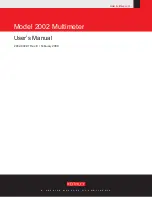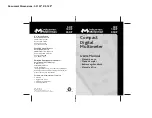
INSTRUCTION MANUAL MC-377+.
Page 35
May 2001
En
gl
is
h
APPENDIX A. DIGITAL TV SIGNALS
Terrestrial Digital Television (abbreviated as TDT) uses COFDM modulation (Coded
Orthogonal Frequency Division Multiplex) which possesses the main feature of
immunity to multi-path reflections.
Whereas the greater part of the power of an analogue channel is centred around the
video carrier, digital signals distribute their energy across the entire channel
bandwidth. This difference has important consequences when measuring the power of
the channel.
TDT channels usually transmit 5 different TV programmes with their corresponding
audio signals and other data, in this same bandwidth an analogue modulation can only
transmit a single TV programme and its corresponding audio signal. Furthermore, due
to the greater efficiency of digital modulation, some 20 dB less power is needed for the
same cover as an analogue signal: therefore, a digital signal with a power of 40 dBµV
at the receiver input is equivalent to a level of 60 dBµV for analogue signals. On the
other hand TDT receivers require a minimum C/N value of between 19 and 26 dB in
order to correctly decode a signal, as opposed to the 43 dB necessary for analogue
signals.
In the case of individual TDT installations without signal amplifiers, it is usually enough
to test the power of the signal at the input. On the other hand, in collective TDT
installations with signal amplifiers (which increase the noise level by adding the noise
they generate) it is also necessary to measure the C/N ratio to guarantee signal quality.
Satellite band uses QPSK modulation (Quadrature Phase Shift Keying) which as with
all digital TV signals uniformly spreads its energy across the entire band.
Digital channels in the satellite band are classified according to their bandwidth into
broad or narrow band channels. Channel bandwidth is uniquely related to Symbol
Rate. This parameter can take many values. Symbol Rate values of the order of 27.500
MBauds are common for broad channels and of the order of 5.000 MBauds for narrow
channels. Naturally enough, the information transmitted across narrow channels is more
limited.
In satellite band, relying solely on measuring power can be deceptive, as signal quality
depends in great measure on the noise introduced by the LNB. It is therefore necessary
to measure the C/N ratio. For the purposes of orientation and digital channels a C/N
ratio of approximately 8 dB may be sufficient for a Symbol Rate of 27.500
MBauds, or approximately 2.3 dB for a Symbol Rate of 5.000 MBauds.
Содержание MC-377+
Страница 2: ......
Страница 4: ......
Страница 5: ...SUMARIO CONTENTS SOMMAIRE Manual espa ol English manual Manuel fran ais Fran ais English...
Страница 6: ......
Страница 8: ...MANUAL DE INSTRUCCIONES MC 377...
Страница 14: ...MANUAL DE INSTRUCCIONES MC 377 P gina 6 Mayo 2001...
Страница 18: ...MANUAL DE INSTRUCCIONES MC 377 P gina 10 Mayo 2001...
Страница 22: ...MANUAL DE INSTRUCCIONES MC 377 P gina 14 Mayo 2001...
Страница 42: ...MANUAL DE INSTRUCCIONES MC 377 P gina 34 Mayo 2001...
Страница 46: ...INSTRUCTION MANUAL MC 377...
Страница 52: ...INSTRUCTION MANUAL MC 377 Page 6 May 2001...
Страница 56: ...INSTRUCTION MANUAL MC 377 Page 10 May 2001...
Страница 60: ...INSTRUCTION MANUAL MC 377 Page 14 May 2001...
Страница 80: ...INSTRUCTION MANUAL MC 377 Page 34 May 2001...
Страница 84: ...MANUEL D UTILISATION MC 377...
Страница 90: ...MANUEL D UTILISATION MC 377 Page 6 Mai 2001...
Страница 94: ...MANUEL D UTILISATION MC 377 Page 10 Mai 2001...
Страница 98: ...MANUEL D UTILISATION MC 377 Page 14 Mai 2001...
Страница 118: ...MANUEL D UTILISATION MC 377 Page 34 Mai 2001...
















































